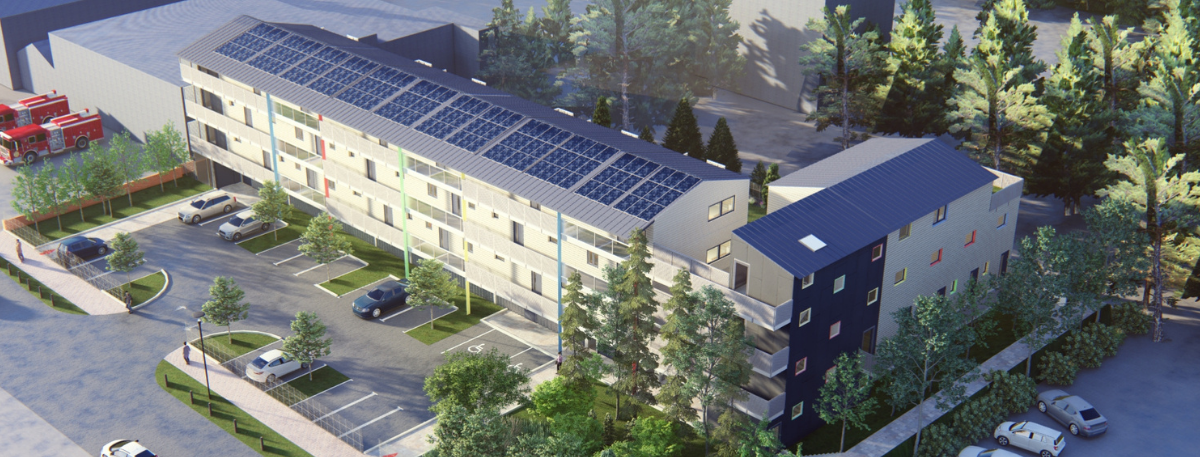Consultation launched on plans for temporary accommodation for homeless people at Henwood Car Park
Published: 14/12/2021
Ashford Borough Council has launched a public consultation into ambitious plans to create new temporary accommodation for homeless people on an under-used car park on the edge of the town centre. Using pre-pandemic figures, Henwood car park operates at around 20% capacity and has been at this level for many years.
The council has appointed ZedPods, who build high-quality factory-produced modular units, to supply 23 homes for the site. They are highly-insulated, triple-glazed homes with heat recovery ventilation and featuring 175 solar panels integrated into the roof. The fabric of the building is designed to create net-zero carbon homes with very low running costs.
The homes are Build Off-site Property Assurance Scheme (BOPAS) accredited, which means that though they are built from non-traditional methods, the product and its materials will last at least 60 years. One of the benefits of using modular construction is that the disruption on site to surrounding residents and businesses during construction will be less than a traditional build. The time it takes to complete the work will also be shortened.
The 23 units of temporary accommodation will be a ‘stepping stone’ until individuals or households who have become homeless are able to move-on to more permanent accommodation.
The car park would be softened by landscaping and would be actively managed by council staff to make sure the site was run efficiently, in a similar way that Christchurch House and Christchurch Lodge, the council’s two other short-stay temporary accommodations sites, are managed.
Sense of community
The 23 homes proposed are a mix of 13 one-bed, nine two-bed and one three-bed units, to ensure a mix of individuals and families can be accommodated. This would help foster a sense of community within the scheme and makes the site easier to manage. There is also a large enclosed garden to the rear. Parking bays for 19 vehicles are proposed, including two disabled bays.
Flooding resilience
While the area technically sits within a flood zone, detailed flood management plans have been produced that will be submitted as part of any future planning application submission. The placement of these modular homes on top of a 2.4m high platform means that they will withstand even the most extreme 100-year (plus climate change) flooding event.

Not only will this development make estimated savings for the council’s General Fund of £5.284m over the life of the project, homeless people staying there will enjoy better living conditions, and the scheme’s intention to be net-zero carbon is a vital consideration for the development.
Have your say in the consultation
The consultation begins in December and runs until 5 January. All comments will be taken into account before finalising the scheme ahead of a planning application.
The consultation is being held on the ZedPods website – as ZedPods is the company the council will partner with to deliver the proposed project.
All nearby businesses and residents are being contacted directly about the consultation to seek their views on the proposal. The intention is to submit a planning application early in the new year.
Legal duty to help
Cllr Paul Clokie, portfolio holder for Housing, said: “Under the Homelessness Reduction Act we have a legal duty to provide anybody who is homeless, or threatened with homelessness, with advice and assistance. This includes the provision of temporary accommodation, and we already have two short-stay accommodation facilities at Christchurch House and Christchurch Lodge.
“These have helped almost 200 households at the most vulnerable time in their lives and have given them an opportunity to start again, to progress from there into accommodation suitable for them. However, the council only has two eight-bed short-stay accommodation facilities, and currently there are over 100 people to whom we have accepted a homelessness duty.
“These people stay in either bed and breakfast accommodation or paid for nightly accommodation. On average these placements cost around £260 per week and, aside from the huge impact this has on those households, it puts a strain on the council’s finances. If we have our own facilities that can house residents, then there are benefits for everyone.
“People who find themselves homeless will be provided with a base upon which they can seek to find more permanent accommodation, while the taxpayer and the council reduce their ongoing financial obligation of paying for third-party temporary accommodation. So we are seeking to provide more short-stay temporary accommodation that means we will, in the long-term, save money and provide a better solution for those people who find themselves homeless.”
Our approach to tackling homelessness
Like all local authorities, Ashford has a duty to house homeless people within the borough. It is important to understand that homelessness is not the same as rough sleeping. People may be homeless because they have lost their job or been evicted from their existing rental property, they may be fleeing domestic violence, a relationship breakdown, or just have lost their way in life. They may even be ‘sofa-surfing’ with no permanent home or may have irrevocably fallen out with family.

Of course, once temporary homes are filled up the council needs to find what is known as ‘move on’ accommodation that enables people to move from these short-stay properties into more permanent solutions that enable them to start rebuilding their lives. That’s why the council is building and acquiring more homes for people to live in.
It has two other schemes and a number of sites that it is developing plans for – these span both homes for older people to live independently in, and more general needs homes, for younger individuals and families. It also is acquiring new-build homes that are delivered through planning section 106 agreements and it is also buying back homes once sold off through the right-to-buy process, in areas where there are other council-owned homes. All of these endeavours increase the number of homes the council has, but demand still exceeds supply.






